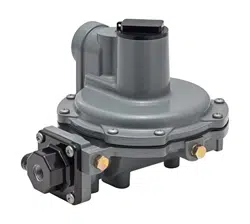Loading ...
Loading ...
Loading ...

R600 and HSRL Series LP-Gas Regulators
7
Make sure the regulator’s closing cap is on tightly, and
maintain drainage away from the dome at all times.
Adjustment
Each regulator is factory set. If it becomes necessary to
increase the outlet pressure, remove the closing cap and
turn the adjustment screw clockwise. Turn the adjusting
screw counterclockwise to decrease the outlet pressure.
The rst stage portion of the Types R632A and R632E
integral regulators is non-adjustable. The outlet pressure
plug may be removed using a 7/16-inch / 11 mm hexagon
wrench. The pressure tap is restricted, so the plug can
be removed with pressure on the outlet of the regulator.
Install a pressure gauge to determine the regulator’s
outlet setting during adjustment, (Actual pressure at the
second stage regulator may be less due to line loss.)
After setting, reinstall the pipe plug and replace the
closing cap. Check the plug for leakage.
Inlet pressure may be checked using the inlet pressure
gauge tap and a pressure gauge. Remove the plug
using a 7/16-inch / 11 mm wrench. The pressure tap is
restricted, so the plug can be removed with pressure on
the inlet of the regulator.
Overpressure Protection
WARNING
!
Some type of overpressure protection is
needed if actual inlet pressure can exceed
the outlet pressure rating. Overpressuring
any portion of this equipment above the
limits shown in the Specications section
may cause damage to regulator parts,
leaks in the regulator, or personal injury
due to bursting of pressure-containing
parts or explosion of accumulated gas.
If any portion of the regulator is exposed
to an overpressure condition that exceeds
the limits in the Specications section, it
must be inspected for damage that may
have occurred.
Large volumes of gas may discharge
through the regulator vent during internal
relief valve operation, which can, if not
controlled, result in re or explosion from
accumulated gas.
The R600 and HSRL Series regulators, except for the
rst stage of the Types R632A and R632E, contain
internal relief valves. The internal relief valve in all units
will give overpressure protection against excessive build-
up resulting from seat leakage due to worn parts or chips
or foreign material on the orice. The amount of internal
relief protection provided varies with the regulator type
and the cause for the overpressure relief valve operation.
When the internal relief valve opens, gas escapes to the
atmosphere through the regulator’s vent.
Some type of additional external overpressure protection
must be provided if the outlet pressure in an overpressure
condition exceeds the inlet pressure rating of the gas
system or downstream equipment. Common methods
of external overpressure protection include relief
valves, monitoring regulators, shutoff devices, and
series regulation.
Maintenance
WARNING
!
To avoid personal injury or equipment
damage, do not attempt any maintenance
or disassembly without rst isolating
the regulator from system pressure and
relieving all internal pressure.
Regulators that have been disassembled
for repair must be tested for proper
operation before being returned to service.
Only parts manufactured by Fisher
®
should
be used for repairing Fisher regulators.
Relight pilot lights according to normal
startup procedures.
Due to normal wear or damage that
may occur from external sources,
these regulators must be inspected and
maintained periodically. The frequency
of inspection and replacement of the
regulators depends upon the severity of
service conditions or the requirements of
local, state, and federal regulations. Even
under ideal conditions, these regulators
should be replaced after 20 years from
date of manufacture or sooner should
inspection reveal the need.
Visually inspect the regulator each time a gas delivery is
made for:
• Improper installation, vent not pointed vertically down or
under a cover; no vent tube on underground systems
• Plugged or frozen vent
• Wrong regulator or no regulator in the system
• Internal or external corrosion
• Flooded Regulator; water in spring case; regulator
submersed on underground tanks
• Regulator age
Loading ...
